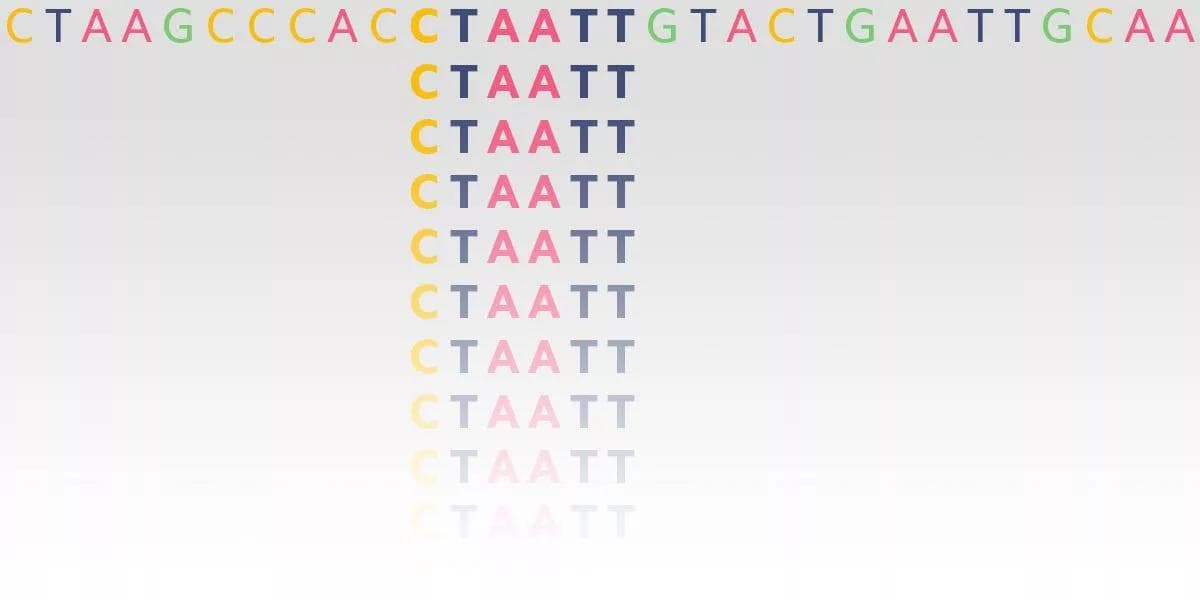Parts of your DNA appear again and again and again. But why?

The significance of repetition in life is almost immeasurable. One of the main benefits of repeating a task is that it gives us a chance to experiment with new approaches, or new methods of reaching the end goal. To put it another way, repetition lets you evolve your methods. In 1970, Dr. Susumu Ohno suggested that DNA evolved in a similar way, saying that repetition within the DNA sequence could have dramatic effects on our traits. Now, more than 50 years later, we know that Dr. Ohno was right—repetition in DNA does affect our traits, and there’s a lot of it.
The theme of repetition is in just about every aspect of human genetics. One of the first things students learn about human genetics is that every person inherits two sets of 22 chromosomes from their parents (one set from each plus a pair of sex chromosomes) that are nearly identical to each other. But today we’re going to focus on one particular type of repetition known as copy number variants, or CNVs for short.
CNVs encompass a wide variety of repetitions, but in its most basic definition, a CNV is any segment of DNA longer than a set number of base pairs (sometimes as low as a few hundred) that occurs in variable numbers between individuals. For example, one individual could have this segment appear in their DNA once; another could have it appear twice.
A CNV in elephants may protect them from cancer
The TP53 gene in elephants is a good illustration of this concept. TP53 is a segment of DNA (approximately 20,000 base pairs long) that tells a cell how to make the p53 protein, which plays an important role in protecting animals from cancer. In theory, large animals like elephants should develop cancer more than others because they have more cells in their body, and thus a statistically higher chance of having any one of those cells turn cancerous. But, that doesn’t seem to be the case. In 2015, it was found that elephants may prevent cancer development with the help of a CNV covering the TP53 gene. Researchers discovered that instead of having just one copy of the TP53 gene, elephants had about 201!
Here, the segment of DNA known as the TP53 gene was duplicated multiple times throughout the elephant’s evolutionary history. During this process, some elephants may have only had 10 copies compared to others with 20. If you were to compare those elephants, you would say that there was a CNV at the TP53 gene because the number of copies varied between individual elephants.
Want to know how your traits are influenced by DNA? We’ve got you covered—just check out the wide range of products in the Helix Store
Humans also have CNVs, and we have a lot of them! CNVs can be as small as a few hundred base pairs, or as big as whole chromosomes. It’s estimated that humans may have as many as 38,000 CNVs in our DNA2. Not all of these affect our traits, but some of them do. Perhaps the most well-known CNV is that of trisomy 21, which results in Down syndrome. In most cases, people have two copies of 23 chromosomes—two copies of chromosome 1, two copies of chromosome 2, two copies of chromosome 3, and so on. However, individuals with Down’s syndrome inherit a third copy of chromosome 21 (hence the term, trisomy 21). This qualifies as a CNV because some people may inherit only two copies of the segment of DNA known as chromosome 21, or they could inherit three.
There are other examples of CNVs in humans with less obvious effects. The AMY1 gene helps us produce a protein in our saliva that helps break down sugars and may affect how we taste them. Scientists have found that people inherit a variable number of copies of AMY1, which may account for a small portion of differences between people in carbohydrate consumption3. There are many more examples where CNVs affect our traits, both health-related and otherwise2-5.
CNVs have been found in the BRCA genes
Understanding how CNVs affect our traits is still an active area of research, and a challenging one at that. Recent developments in bioinformatics have made it possible to detect CNVs, which has opened the door to many new genetic insights. With the ability to analyze a person’s DNA for CNVs, researchers can start to learn how repetition in the DNA may alter our traits or affect our health. For example, CNVs in the BRCA genes have recently been shown to modify a person’s odds of developing breast cancer, leading to DNA tests seeking to help people understand if they’re likely to develop some form of cancer later in life5. As we come to understand more about CNVs, they’ll likely continue to mold the way we view genetics and its impact on our lives.
- “How Elephants Avoid Cancer.” Nature News, Nature Publishing Group, www.nature.com/news/how-elephants-avoid-cancer-1.18534.
- Zhang, Feng et al. “Copy Number Variation in Human Health, Disease, and Evolution.” Annual review of genomics and human genetics 10 (2009): 451–481. PMC. Web. 30 Aug. 2018
- Carpenter, Danielle, Laura M. Mitchell, and John A. L. Armour. “Copy Number Variation of Human AMY1 Is a Minor Contributor to Variation in Salivary Amylase Expression and Activity.” Human Genomics 11 (2017): 2. PMC. Web. 30 Aug. 2018.
- Dumas, Laura et al. “Gene Copy Number Variation Spanning 60 Million Years of Human and Primate Evolution.” Genome Research 17.9 (2007): 1266–1277. PMC. Web. 30 Aug. 2018.
- Walker, Logan C et al. “Evaluation of Copy-Number Variants as Modifiers of Breast and Ovarian Cancer Risk for BRCA1 Pathogenic Variant Carriers.” European Journal of Human Genetics 25.4 (2017): 432–438. PMC. Web. 30 Aug. 2018.